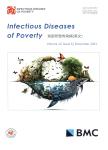Estimated need for anthelminthic medicines to control soil-transmitted helminthiases in school-aged children,2020–2030
Estimated need for anthelminthic medicines to control soil-transmitted helminthiases in school-aged children, 2020–2030作者机构:Department of Control of Neglected Tropical DiseasesWorld Health OrganizationGenevaSwitzerland Swiss Tropical and Public Health InstituteBaselSwitzerland University of BaselBaselSwitzerland
出 版 物:《Infectious Diseases of Poverty》 (贫困所致传染病(英文))
年 卷 期:2020年第9卷第3期
页 面:74-83页
核心收录:
学科分类:1002[医学-临床医学] 100201[医学-内科学(含:心血管病、血液病、呼吸系病、消化系病、内分泌与代谢病、肾病、风湿病、传染病)] 10[医学]
基 金:The study was initially conducted as a Master’s thesis by the first author and then formatted as a publication these activities were conducted without external funding
主 题:Preventive chemotherapy Soil-transmitted helminthiases Drug donations
摘 要:Background:Soil-transmitted helminthiases(STH)are part of the group of neglected tropical diseases traditionally treated with preventive chemotherapy *** recent years,drug donations have been essential to expanding preventive chemotherapy and achieving progressive control of morbidity from *** study aims to evaluate the need for anthelminthic medicines during 2020–***:To estimate the need for anthelminthic medicines,we considered three different scenarios:(1)the control programmes continues to expand coverage and maintains the frequency of drug administration established at baseline;(2)the programmes continues to expand coverage but adapts the frequency of drug administration when the STH prevalence is reduced and(3)the STH programme becomes self-sustainable in some endemic ***:We estimate that the number of anthelmintic medicines needed to treat school-aged children will increase by 40%by 2025 and by 52%by 2030 if countries do not change the frequency of preventive chemotherapy(scenario 1);that the number of tablets needed will reduce by 32.4%by 2025 and by 49.1%in 2030 if endemic countries reduce the frequency of preventive chemotherapy(scenario 2);and drug donations could be reduced by 54.4%by 2025 and 74.4%by 2030 if some endemic countries could become independent in drug procurement(scenario 3).Conclusions:The number of anthelmintic medicines needed to achieve elimination of morbidity due to STH in school-aged children will decline during 2020–*** decline will be substantial if a number of“upper-middle incomecountries in which STH are endemic procure,as expected,anthelminthic medicines independently.



